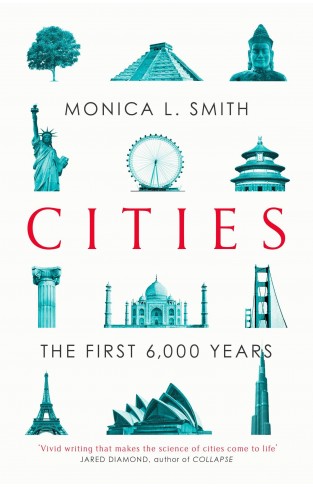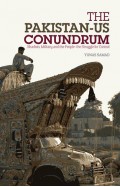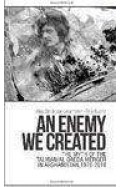Cities: The First 6,000 Years
By: Monica L. Smith
-
Rs 3,896.75
- Rs 5,995.00
- 35%
You save Rs 2,098.25.
Due to constant currency fluctuation, prices are subject to change with or without notice.
A FASCINATING INVESTIGATION INTO THE HISTORY OF CITIES: WHY DID THEY OCCUR, HOW HAVE THEY EVOLVED, WHY DO SO MANY OF US CHOOSE TO LIVE IN THEM AND HOW DO THEY AFFECT US?
‘Monica Smith is the person best qualified to write a book about the big problems raised by the increasing concentration of the human population into cities. She also has a gift for vivid writing that will make the science of cities come to life for the broad public. I expect that CITIES will be a great read and will sell well.’
Jared Diamond, author of Collapse
Over half of the world’s population lives in an urban area and cities around the globe are getting bigger and bigger. Love them or hate them, more and more of us are choosing to live in them.
Cities investigates the following intriguing questions: why did cities start to occur around 6,000 years ago, how have they evolved, why do so many of us choose to live in them, how do they affect us, and what does the future hold at a time when we’re increasingly connected by technology?
In Cities, Monica L. Smith points out that, even if you don’t live in a city, your life is inevitably affected by one, whether you commute into one for work, sell coffee beans to a company that supplies urban coffee shops, or host city-dwelling tourists seeking adventure and respite from the city in your remote village.
Using fascinating anecdotes and research findings from her work as an archaeologist, Smith also reveals that many of the problems that we associate with modern cities (violence, hyperconsumption, etc.) have, in fact, always existed. And, more positively, how many of the things that draw us to cities in modern times (educational and economic opportunities, social mobility, culture) are the things that have drawn us to them since they first appeared.
She also makes the controversial argument that it’s down to cities that the middle class exists and she examines why social movements flourish in cities in a way they rarely do in rural settings.
A FASCINATING INVESTIGATION INTO THE HISTORY OF CITIES: WHY DID THEY OCCUR, HOW HAVE THEY EVOLVED, WHY DO SO MANY OF US CHOOSE TO LIVE IN THEM AND HOW DO THEY AFFECT US?
‘Monica Smith is the person best qualified to write a book about the big problems raised by the increasing concentration of the human population into cities. She also has a gift for vivid writing that will make the science of cities come to life for the broad public. I expect that CITIES will be a great read and will sell well.’
Jared Diamond, author of Collapse
Over half of the world’s population lives in an urban area and cities around the globe are getting bigger and bigger. Love them or hate them, more and more of us are choosing to live in them.
Cities investigates the following intriguing questions: why did cities start to occur around 6,000 years ago, how have they evolved, why do so many of us choose to live in them, how do they affect us, and what does the future hold at a time when we’re increasingly connected by technology?
In Cities, Monica L. Smith points out that, even if you don’t live in a city, your life is inevitably affected by one, whether you commute into one for work, sell coffee beans to a company that supplies urban coffee shops, or host city-dwelling tourists seeking adventure and respite from the city in your remote village.
Using fascinating anecdotes and research findings from her work as an archaeologist, Smith also reveals that many of the problems that we associate with modern cities (violence, hyperconsumption, etc.) have, in fact, always existed. And, more positively, how many of the things that draw us to cities in modern times (educational and economic opportunities, social mobility, culture) are the things that have drawn us to them since they first appeared.
She also makes the controversial argument that it’s down to cities that the middle class exists and she examines why social movements flourish in cities in a way they rarely do in rural settings.
Zubin Mehta: A Musical Journey (An Authorized Biography)
By: VOID - Bakhtiar K. Dadabhoy
Rs 472.50 Rs 1,050.00 Ex Tax :Rs 472.50
The Origins of Political Order From Prehuman Times to the French RevolutioN
By: Francis Fukuyama
Rs 3,116.00 Rs 3,895.00 Ex Tax :Rs 3,116.00
Manning Up: How the Rise of Women Has Turned Men into Boys
By: Kay Hymowitz
Rs 646.75 Rs 995.00 Ex Tax :Rs 646.75
The Obama Syndrome: Surrender At Home War Abroad
By: Tariq Ali
Rs 1,036.00 Rs 1,295.00 Ex Tax :Rs 1,036.00
The Quest For Meaning: Developing A Philosophy Of Pluralism
By: Tariq Ramadan
Rs 1,116.00 Rs 1,395.00 Ex Tax :Rs 1,116.00
The Pakistan US Conundrum Jihadists The Military And The People The Struggle For Control
By: Yunas Samad
Rs 1,116.00 Rs 1,395.00 Ex Tax :Rs 1,116.00
An Enemy We Created: The Myth Of The Taliban Al Qaeda Merger In Afghanistan 19702010
By: Alex Strick van Linschoten
Rs 3,412.50 Rs 5,250.00 Ex Tax :Rs 3,412.50
WikiLeaks: Inside Julian Assanges War on Secrecy
By: David Leigh & Luke Harding
Rs 552.50 Rs 850.00 Ex Tax :Rs 552.50
No recently viewed books available at the moment.
Zubin Mehta: A Musical Journey (An Authorized Biography)
By: VOID - Bakhtiar K. Dadabhoy
Rs 472.50 Rs 1,050.00 Ex Tax :Rs 472.50













-120x187.jpg?q6)





-120x187.jpg?q6)
-120x187.jpg?q6)

-120x187.jpg?q6)



-120x187.jpg?q6)



